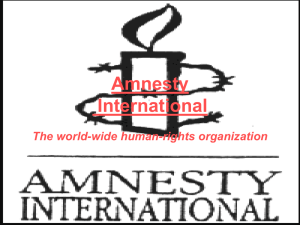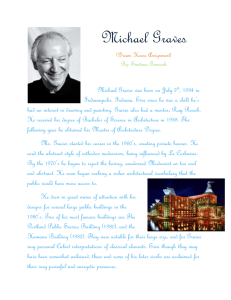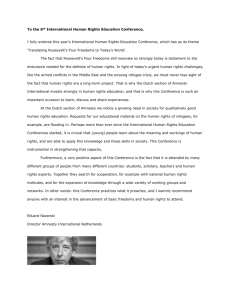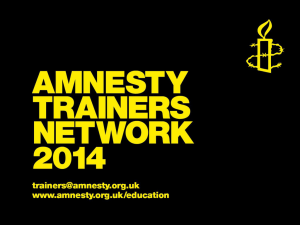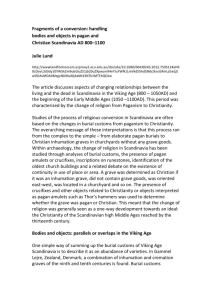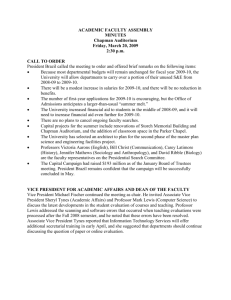Burundi: Suspected Mass Graves of Victims of 11 December Violence
advertisement
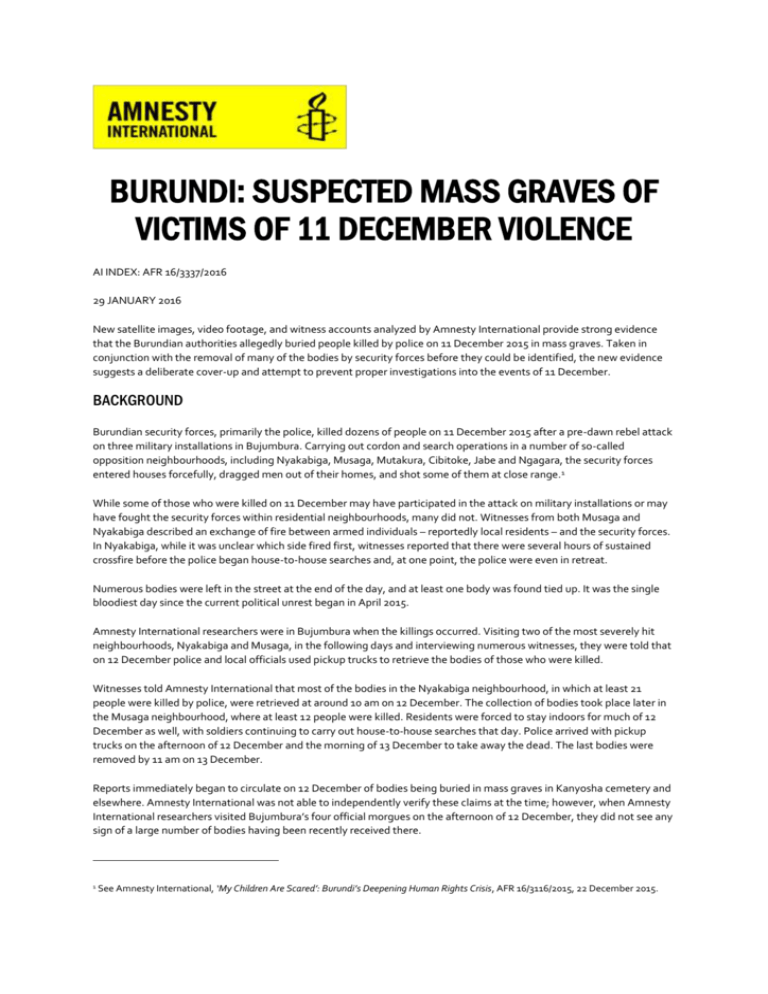
BURUNDI: SUSPECTED MASS GRAVES OF VICTIMS OF 11 DECEMBER VIOLENCE AI INDEX: AFR 16/3337/2016 29 JANUARY 2016 New satellite images, video footage, and witness accounts analyzed by Amnesty International provide strong evidence that the Burundian authorities allegedly buried people killed by police on 11 December 2015 in mass graves. Taken in conjunction with the removal of many of the bodies by security forces before they could be identified, the new evidence suggests a deliberate cover-up and attempt to prevent proper investigations into the events of 11 December. BACKGROUND Burundian security forces, primarily the police, killed dozens of people on 11 December 2015 after a pre-dawn rebel attack on three military installations in Bujumbura. Carrying out cordon and search operations in a number of so-called opposition neighbourhoods, including Nyakabiga, Musaga, Mutakura, Cibitoke, Jabe and Ngagara, the security forces entered houses forcefully, dragged men out of their homes, and shot some of them at close range.1 While some of those who were killed on 11 December may have participated in the attack on military installations or may have fought the security forces within residential neighbourhoods, many did not. Witnesses from both Musaga and Nyakabiga described an exchange of fire between armed individuals – reportedly local residents – and the security forces. In Nyakabiga, while it was unclear which side fired first, witnesses reported that there were several hours of sustained crossfire before the police began house-to-house searches and, at one point, the police were even in retreat. Numerous bodies were left in the street at the end of the day, and at least one body was found tied up. It was the single bloodiest day since the current political unrest began in April 2015. Amnesty International researchers were in Bujumbura when the killings occurred. Visiting two of the most severely hit neighbourhoods, Nyakabiga and Musaga, in the following days and interviewing numerous witnesses, they were told that on 12 December police and local officials used pickup trucks to retrieve the bodies of those who were killed. Witnesses told Amnesty International that most of the bodies in the Nyakabiga neighbourhood, in which at least 21 people were killed by police, were retrieved at around 10 am on 12 December. The collection of bodies took place later in the Musaga neighbourhood, where at least 12 people were killed. Residents were forced to stay indoors for much of 12 December as well, with soldiers continuing to carry out house-to-house searches that day. Police arrived with pickup trucks on the afternoon of 12 December and the morning of 13 December to take away the dead. The last bodies were removed by 11 am on 13 December. Reports immediately began to circulate on 12 December of bodies being buried in mass graves in Kanyosha cemetery and elsewhere. Amnesty International was not able to independently verify these claims at the time; however, when Amnesty International researchers visited Bujumbura’s four official morgues on the afternoon of 12 December, they did not see any sign of a large number of bodies having been recently received there. 1 See Amnesty International, ‘My Children Are Scared’: Burundi’s Deepening Human Rights Crisis, AFR 16/3116/2015, 22 December 2015. BURUNDI:2SUSPECTED MASS GRAVES OF VICTIMS OF 11 DECEMBER VIOLENCE One of the main morgues was deserted when the delegation arrived and appeared to be empty. Two hospital morgues had received bodies from the targeted neighbourhoods that day, but only one body had been received in one location and two in the other. The absence of bodies has hindered any meaningful investigation into the killings. It has also made it impossible to ascertain exactly how many people were killed by the security forces on 11 December. SATELLITE IMAGERY AND VIDEO FOOTAGE OF SUSPECTED MASS GRAVES IN BURINGA AREA Satellite imagery and video footage analyzed by Amnesty International is consistent with witness accounts that mass graves were dug on the afternoon of 11 December in the Buringa area, about 12 km north of central Bujumbura. The site of the suspected graves is a disused cemetery, just across Route Nationale 5 (RN5) from Mpanda cemetery, and not far from the country’s international airport.2 Map showing the approximate locations of suspected mass graves in the Bujumbura area (c) Amnesty International. Made with Natural Earth. Both the satellite pictures and the video show an area of disturbed earth 118 metres east of RN5, revealing signature indications of mass graves. Video analysis allowed Amnesty International to pinpoint the exact location of the site. Subsequent analysis of satellite imagery taken on 3 November 2015, prior to any reports of mass graves in the area, shows an undisturbed patch of ground with light grass cover typical of open areas in the region. 2 Satellite image analysis was conducted by commercial satellite image provider DigitalGlobe. Video footage of Buringa, Bujumbura, provided by witness. Amnesty International January 2016 Index: AFR 16/3337/2016 BURUNDI:3 SUSPECTED MASS GRAVES OF VICTIMS OF 11 DECEMBER VIOLENCE This graphic is based on a satellite imagery pre-event, from 3 November 2015, and is used to show location only. Photographs are screenshots from a video taken after the graves were dug (c) DigitalGlobe. Google Earth. Produced by Amnesty International. Video analysis identifies five separate graves within a larger area of disturbed earth. Judging by satellite imagery dating from 22 December 2015, the approximate size of the whole area is 49 m2. The analysis corroborates testimony describing five graves. Satellite image shows undisturbed earth in early November 2015. (c) DigitalGlobe. Amnesty International January 2016 Index: AFR 16/3337/2016 BURUNDI:4SUSPECTED MASS GRAVES OF VICTIMS OF 11 DECEMBER VIOLENCE Satellite image showing disturbed earth in the Buringa area, which is consistent with witness accounts and video footage of mass graves. (c) DigitalGlobe. A review of satellite imagery and video footage of the suspected mass burial site shows undisturbed and intact grass surrounding the site, suggesting that the grave was dug with simple hand equipment such as shovels. OTHER SUSPECTED MASS GRAVE SITES The suspected mass grave site in the Buringa area is not the only place where the bodies of people killed on 11 December 2015 are believed to have been buried. Amnesty International has received credible reports of suspected mass graves in several other locations, including Mpanda cemetery and Kanyosha cemetery. A team from France 24 visited the Kanyosha site in late December 2015. France 24 broadcast footage showing an area of what looks like freshly turned earth, together with an interview with a man who claimed that he had helped carry bodies to the cemetery.3 Local sources told Amnesty International that 25 bodies were buried in five graves at the Mpanda site, and 28 bodies were buried in four graves at the Kanyosha site. While it is not known how many bodies might be found at other sites, the UN 3 “Enquête sur les accusations d’exécutions sommaires au Burundi,” France 24, 30 December 2015 (available at: https://www.youtube.com/watch?v=lC76yxfr6RU). Amnesty International January 2016 Index: AFR 16/3337/2016 BURUNDI:5 SUSPECTED MASS GRAVES OF VICTIMS OF 11 DECEMBER VIOLENCE High Commissioner for Human Rights reported that his office had received witness reports of nine mass grave sites in Bujumbura and its surroundings, including in a military camp, containing more than 100 bodies in total of people killed on 11 December.4 CONCLUSION AND RECOMMENDATIONS Burundi’s Prosecutor General Valentin Bagorikunda announced in mid-December that he had tasked a team of magistrates to investigate allegations of extrajudicial executions during the events of 11 December and report back within a month. In January 2016, he wrote to the team of three magistrates instructing them that they were also required to investigate allegations of mass graves following the 11 December attacks. To date, the investigating team have not announced any findings. The Office of the High Commissioner for Human Rights has also announced that it is analyzing satellite imagery of the reported mass grave locations, calling for an independent investigation and the safeguarding of the sites. A team of experts comprising two UN Special Rapporteurs and a member of the African Commission on Human and Peoples’ Rights (ACHPR) and mandated by the UN Human Rights Council (HRC) to investigate violations and abuses of human rights in Burundi has not yet been able to deploy as planned given the lack of response from the Burundian authorities. It is essential that the fate of people who were killed on 11 December is ascertained, and that independent investigations can be carried out. Amnesty International makes the following recommendations: To the Government of Burundi: Ensure that all the suspected mass grave sites are secured and protected from any tampering; Allow independent international and regional human rights monitors and investigators full access to the sites. The suspected grave sites should be opened up, and any bodies found in them exhumed and subject to forensic examination to assess the causes of death and to establish the victims’ identities; Ensure that the identified bodies are returned to the victims’ families for a proper burial; Facilitate the immediate deployment of the HRC-mandated team of experts to Burundi, including through issuing visas; If independent investigations reveal sufficient admissible evidence, prosecute in a fair trial before an ordinary civilian court, without recourse to the death penalty, anyone suspected of criminal responsibility for crimes under international law and human rights violations. To regional and international bodies, in particular the African Union Peace and Security Council (AU PSC), the United Nations Security Council (UNSC) and the HRC: Provide their human rights monitoring teams with all political and financial support necessary to carry out investigations into the events of 11 December, especially the suspected mass grave sites; Urge the Government of Burundi to allow such investigations to go ahead as a matter of urgency. To the AU Peace and Security Council: Adopt a resolution at the upcoming Assembly of the Heads of State and the meeting of the Peace and Security Council urging prompt, impartial and independent investigations into the events of 11 December, including by allowing and facilitating unfettered access to all suspected mass grave sites. 4 OHCHR, “Alarming new patterns of violations emerging in Burundi – Zeid,” 15 January 2016 (available at: http://www.ohchr.org/SP/NewsEvents/Pages/DisplayNews.aspx?NewsID=16953&LangID=E) Amnesty International January 2016 Index: AFR 16/3337/2016
